Rocky juniper: description, varieties and cultivation

Coniferous shrubs are one of the main "tools" in the creation of landscape compositions. A special place among them is occupied by rocky junipers, which can not only diversify the territory adjacent to the house, but also ennoble city parks, squares and streets.
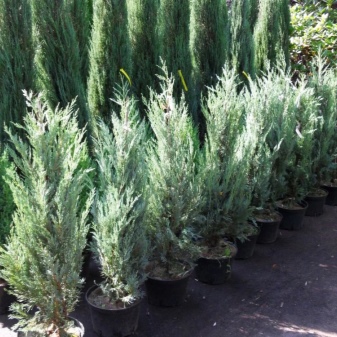
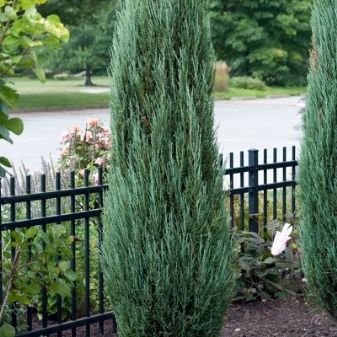
Description
This type of juniper belongs to the genus Cypress. The adjective "rocky" in the name of the shrub speaks of the places of its growth in nature, and these slopes are located mainly in the USA and Canada. In our country, the first mentions of this "overseas" culture appeared in the 19th century, and a little later they began to actively cultivate it, since in everyday life it was simply irreplaceable: strong wood served as an excellent raw material for making dishes and other items necessary for human life.
An important feature of these evergreen shrubs is their longevity. There are even trees that are more than several hundred years old.


The description of the rocky juniper will help novice gardeners and landscape designers to organically fit it into the created natural compositions.
- In its homeland, this representative of the flora can grow up to 16 meters in height. However, in adjoining plots, in parks, squares and other open areas of the city, the seedling grows to a maximum of 13 meters, but this does not prevent it from effectively decorating the area.
- A powerful trunk in diameter can reach from 85 to 200 centimeters, depending on age and growing conditions. The bark is layered, has a dark brown (adult species) or green-blue (young seedlings) color.
- The crown of a young juniper is mostly cone-shaped, while that of a perennial is more rounded. It is formed in most cases from the base.
- The branches are abundantly covered with needle-like needles. If you look closely, it may seem that they consist of small scales.
- The cone berries, which are the fruits of a juniper, are dark blue in color, and on top they are covered with a gray-blue bloom that visually resembles frost. Upon reaching two years, seeds appear inside (2 pieces in each).
The annual growth rates of the rocky species are not very high: in 365 days they do not grow more than 20 centimeters. Plants are cross-pollinated. This is due to the fact that they are dioecious, that is, male flowers grow on one shrub, and female flowers on the other.
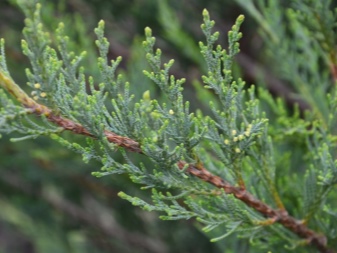
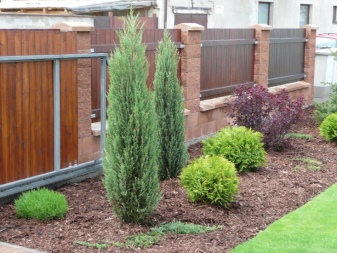
Varietal variety
Rocky juniper is represented not by one variety, but by a dozen. Moreover, their external signs are so different that sometimes you don't even think that they belong to the same coniferous culture.
Blue Arrow
The species got its name for a reason (translated as "blue arrow"): vertical branches growing from the very base, tightly pressed to the trunk and covered with rich bluish needles, form a crown that visually resembles the mentioned object. To some, the shape looks like a column. Both options take place, as they accurately describe the appearance of the culture.
This type of juniper is one of the most stable and durable, as it has tough shoots that do not care about any unfavorable conditions, precipitation and temperature fluctuations.
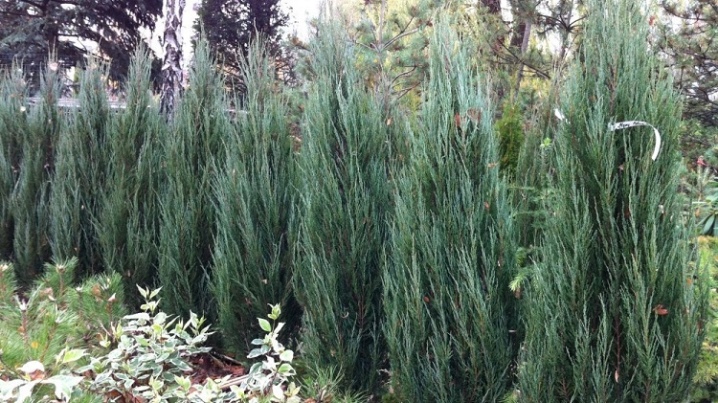
Blue Heaven
The literal translation is "blue sky".This species is especially popular with landscape designers for its truly stunning bright blue needles, which remain so all year round, without changing a single shade. The needles themselves are of standard (medium) length, prickly and tough. They become scaly over the years. Shoots grow quickly, forming a pin-shaped crown, the straight trunk is completely covered with branches.
The advantages of the variety are drought tolerance, frost resistance, unpretentiousness. Disadvantages - susceptible to rust diseases, poorly tolerates gas-polluted air, not very strong branches often do not withstand snow masses and break.

Fischt
This variety is characterized by matte blue-green needles. The dense crown formed with its help and young shoots growing almost from the ground itself make the culture look like a pyramid.
This is one of the tallest types of rocky juniper: in some cases, the shrub grows above 10 meters. The variety is not afraid of subzero temperatures, takes root on any soil, in one area it can grow up to 10-12 years. Rust is the disease that can affect this juniper most often, so it should be planted as far as possible from the main carriers - fruit trees.
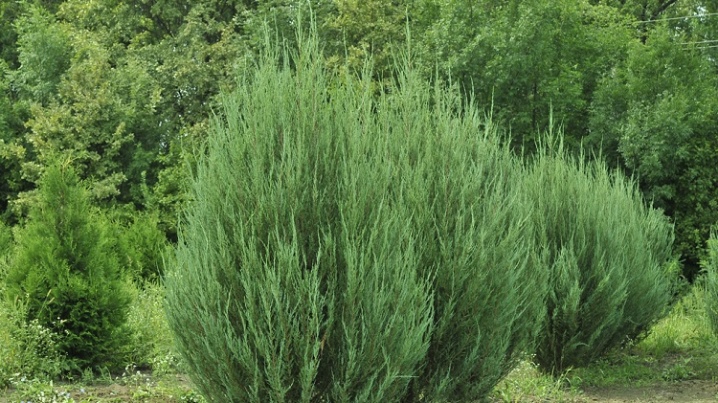
Wichita Blue
The most beautiful variety in terms of color of needles - it is bright, sky-blue, does not change its shade throughout the year. The height of the shrub is average - 6.5 meters maximum. The crown is keglevid, wide, formed by tetrahedral shoots directed upwards. May grow loose in conditions of increased shade.
In general, the variety is not very whimsical both to the ground and to the surrounding conditions. In winter, it may need to be sheltered from the snow, as the branches are not very strong.
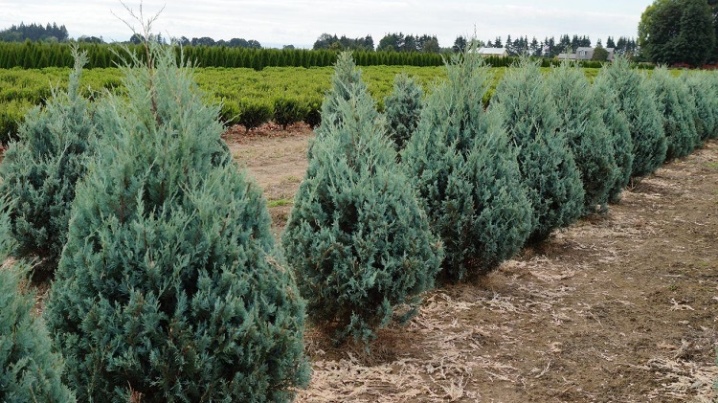
Moffat Blue
For domestic gardeners and landscape decorators, this variety is relatively new, although it has been grown in America since 1937. That's why it is impossible to say exactly what a tree will look like on the site: it can be similar to the species grown at home, or differ from them. As a rule, such a juniper in our conditions does not grow very quickly and reaches a height of 1.8-2 meters.
The needles are bluish-green or silvery-green (depending on age). Forms a wide crown-shaped crown. It becomes more rounded over the years.
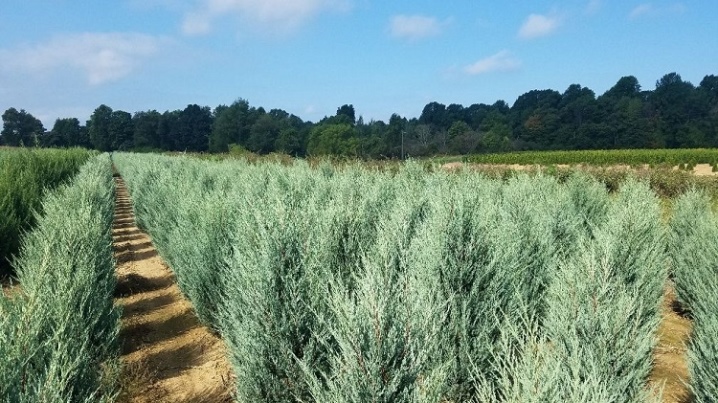
Springbank
Not very popular, but very interesting variety. This is due to the presence of thin, long, flexible shoots, which often do not stretch up, but hang down, giving the tree an openwork appearance. They are covered with short scaly needles of a sky-blue hue, which is characterized by increased thorniness. It is better to plant such a tree in sunny areas, while the shade can lead to a loss of color intensity. The crown is pyramidal, but rather narrow.
It can reach a height of 4 meters. The bush is unpretentious in care and maintenance: it does not require watering, it is not afraid of the cold, it does not break from gusts of wind. Due to its peculiar appearance, such a juniper is preferable to plant in gardens of a free, rather than formal style.
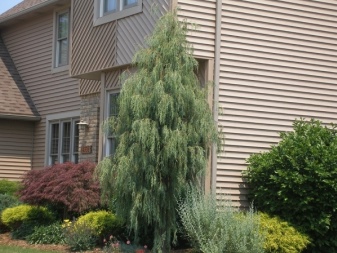

Pathfinder
A fast growing variety that can grow up to 6 meters in height. In this regard, the shrub is often used to create a hedge. The needles of this rocky juniper are of a rich green color, however, with the onset of cold weather, it becomes golden. This must be taken into account when decorating garden plots and city parks. In addition, it is flexible, thornless, scaly, pointed at the tips. The branches are straight, close to each other, have a silvery-blue bloom. The crown has an expanded keglevid shape.
The coniferous shrub is very picky: it can grow quietly in any areas and soils, does not need frequent watering and shelters, it experiences temperature drops and frost without stress.However, for planting, it is better to choose areas illuminated by sunlight or places with a slight partial shade, otherwise the decorative properties of the variety will be lost.
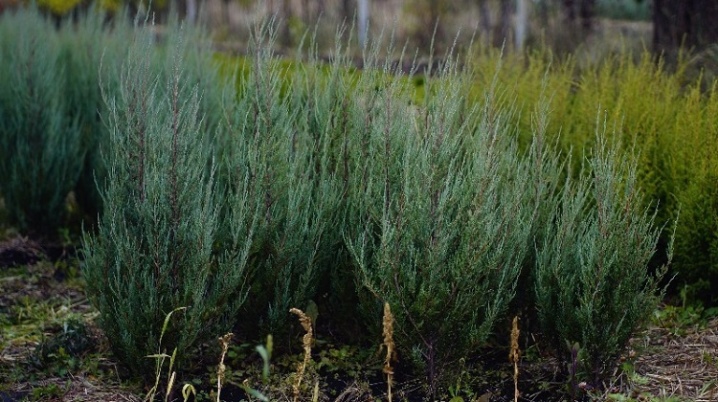
Silver Star
This is a very exotic species, as the crown combines the needles of green and cream shades. The tree itself resembles a column in appearance. This shape is formed thanks to strong vertical shoots that grow straight up, not deviating even a degree. Such a juniper grows very slowly, a perennial tree sometimes reaches a height of only 3 meters. Therefore, the best use is to decorate landscape compositions and small gardens.
As for the places for planting crops, it is worth choosing, as in all other cases, sunny areas, but with little shading. The juniper is not so picky about the composition of the soil and moisture, it tolerates frosts calmly. However, you still have to tie it up for the winter, since the snow can bend the shoots.
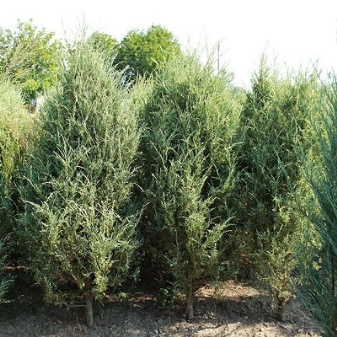
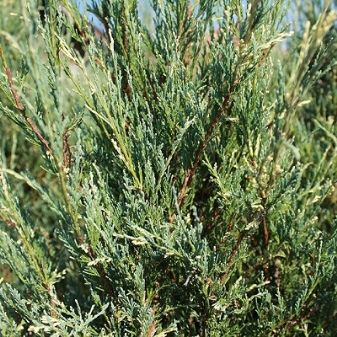
Landing
The culture can grow in regions with different climates. For disembarkation, it is better to choose remote, uncrowded areas, moderately lit and not flooded with water. It should be noted that rocky juniper is not very fond of too fertile soil. If on your site it is exactly like that, then sand is poured into it, gravel, small pebbles are added, screening. Permeability and looseness are achieved through the same sand or sod land. Lime will help get rid of high acidity. Small stony inclusions in the soil are possible, but there should not be too many of them, as well as compaction, close location of groundwater.
You can plant rocky juniper in autumn and spring. In the first case, planting is possible in zones with a temperate or warm climate, and in the second - only in the north, so that the shrub can take root and not die.
Burnout in the sun should not be feared, since it is not very active there.
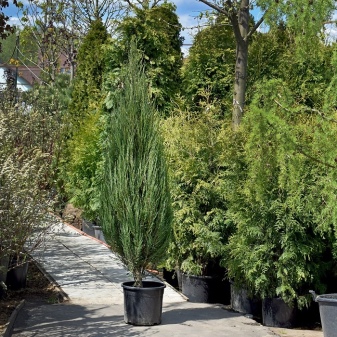

During the first two years after planting in open ground, the seedling needs to be protected from the wind. During this time, the root system will sufficiently strengthen and grow, as a result of which the tree will not be afraid of squalls of wind, or hurricanes, or other whims of nature. The planting hole should be so deep that not only the root system is placed there, but also the drainage layer. The latter is added to the dug hole first (about 20 cm), ground is poured on top (2/3 of the total volume). Then the pit is watered abundantly and left for 2 weeks.
It is better to purchase rocky juniper seedlings in proven nurseries. Private traders have a high probability of buying a defective or diseased plant. If, nevertheless, it was decided to take this coniferous shrub from the hands, then be sure to pay attention to the fact that its root must be in the ground (the diameter is equal to the projection of the crown) and laid in burlap or be in a container, and in both case, the substrate must be moist. The needles should have a uniform color and smell appropriately, and there should be no traces of rot, mold, damage, fractures on the shoots, in addition, it is necessary that they bend well.
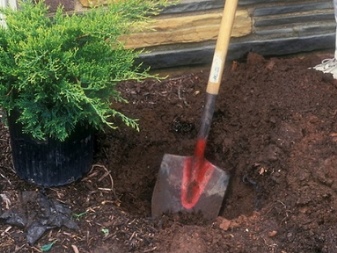
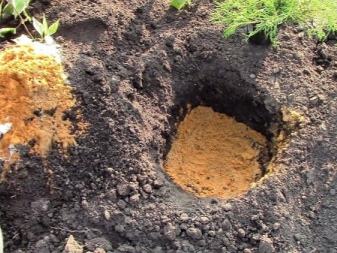
You need to plant a juniper immediately after purchase, otherwise you will need to take care that the needles and root system do not dry out.
To plant a shrub correctly, you should adhere to a certain sequence:
- a small part of the soil is removed from the pit with the prepared composition;
- a seedling with an earthen lump is placed in the center, while the root collar should not be deepened or be too high, the optimal location is at the level of the edge of the hole so that after sprinkling it is not hidden underground;
- the extracted soil is returned to the hole, which should be compacted in the process in order to avoid the formation of voids;
- produce watering and mulching.
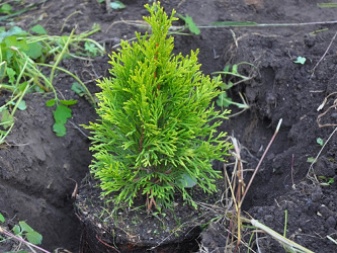
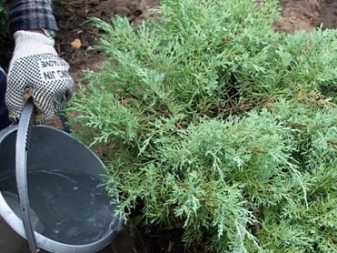
Care
You need to water the rocky juniper regularly, but in moderation:
- in hot dry summer, the soil is moistened 1 time in 7 days;
- in rainy weather, watering may not be carried out at all in order to prevent root rot;
- in a cool cloudy summer, water is added to the trunk circle if the soil has dried out deeper than 5-6 cm;
- perennial junipers are watered 3 times per season, not more often.
Sprinkling is also a necessary process that will help the needles look bright and beautiful. It is necessary to carry out the procedure after lunch, and for this you need to use water at room temperature, which has been defended for several days.
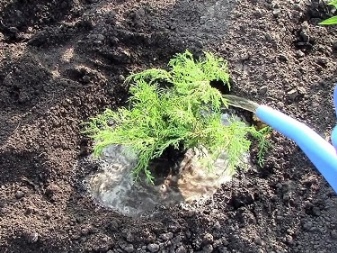
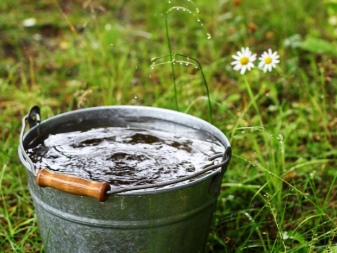
Oxygen and moisture are natural "stimulators" for the growth and proper development of any plant, including juniper. A timely loosening procedure will help to achieve the receipt of these components. The soil is cultivated to a depth of 3-4 cm, otherwise the root system can be accidentally damaged. Mulching will help to avoid premature evaporation of moisture and the appearance of weeds during cultivation. For shelter, as a rule, sawdust, peat, pine chips are used.
The branches of most junipers are located close to each other and are covered with abundant needles, as a result of which the crown is quite dense. Because of this, the shoots located in the center do not receive enough light, which is why they dry out, change color, and lose their visual appeal. As a result, the tree looks painful, ugly.
Also, in this case, the culture becomes a place of settlement and habitat for many pests, moreover, spores of various fungal diseases often appear there, and subsequently actively multiply.

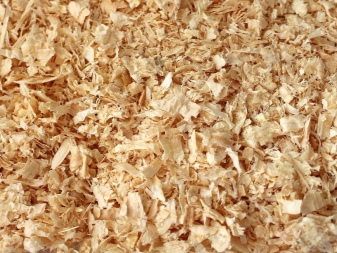
From all this, we can conclude that pruning is an important measure for plant care. It is possible to cut the crop, as a rule, throughout all the spring months, and in the northern regions - even until mid-June. First of all, they get rid of damaged (dry, broken) branches directly at the trunk.
The rocky juniper almost does not need a decorative haircut, since its crown looks beautiful anyway. However, sticking out branches can be removed if desired. This is done with garden shears or electric hedge trimmers. Perennial pyramidal junipers also periodically need formative pruning. It will help to form a beautiful and neat crown, since over the years the shoots begin to creep in different directions. The root system also needs protection from the cold, for which a rather thick layer of peat is placed near the trunk.

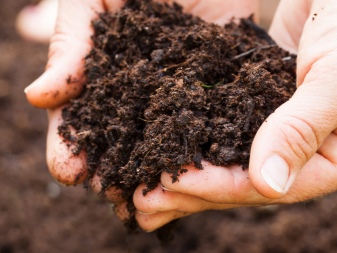
Reproduction methods
Get new conifers in three ways:
- vaccination;
- seeds;
- cuttings.
The first method is quite difficult, especially for novice gardeners. Therefore, it is worth choosing it in very extreme cases.
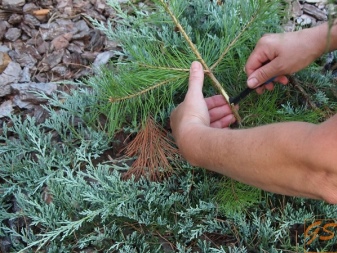
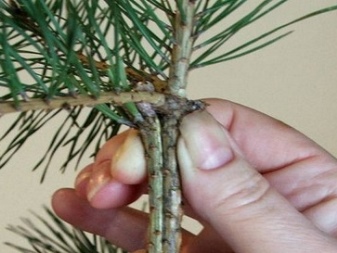
The second is more effective, but it differs in duration, and it is not always possible to obtain a shrub with all the characteristic species characteristics. Therefore, the most reliable, effective and, perhaps, the simplest way is cuttings. In general, it is possible to separate the stalk from the tree throughout the year, however, it is better for those who have recently started breeding to carry out the operation in the spring, since the shoots obtained in another season may need a special room, equipment, funds that a beginner may not have in force of inexperience.
To obtain good planting material, take the so-called "heel" shoot, from which all needles are removed immediately after the cut. After that, it is treated with a stimulant and planted in perlite, sand, or its combination with peat. Keep such a cutting should be in a cool room with a high level of humidity. After the roots appear (this usually happens after a month and a half), it is transferred to a light soil mixture.

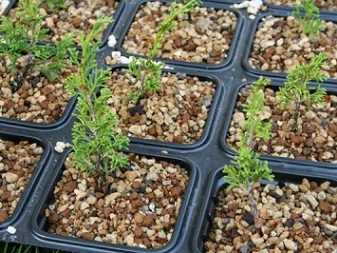
Diseases and pests
This is not to say that rocky juniper is a weak culture.However, if the rules of care or maintenance are violated, it may be characterized by some ailments, under the influence of which it dries up or dies.
Most often, the culture is affected by a disease such as rust. It can be recognized by orange oily growths that rapidly begin to cover the trunk and branches. The disease must be fought immediately, cutting and burning infected shoots, otherwise the tree will have to be completely cut down. For prevention, you can irrigate juniper with fungicides, among which the most effective are copper sulfate, Bayleton, Skor.
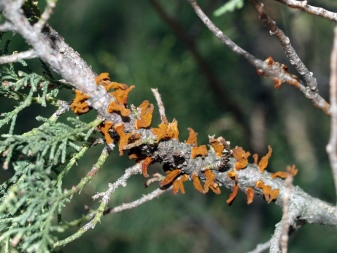

No less dangerous for the coniferous shrub is Fusarium, a fungal-type disease that leads to drying out and falling off of needles and shoots. Such parts of the tree can be recognized by their brownish-red hue. They are struggling with the problem like this:
- remove the affected areas;
- the whole tree and the trunk circle are treated with Fitosporin-M, copper sulfate, and Quadris.
With the onset of spring, it is often possible to notice that the needles of the juniper have turned yellow, the bark has become covered with peculiar growths, and the branches have dried up. In this case, as in the situations above, the diseased parts are removed, and then spraying with "Skor", "Ridomil Gold" is carried out.
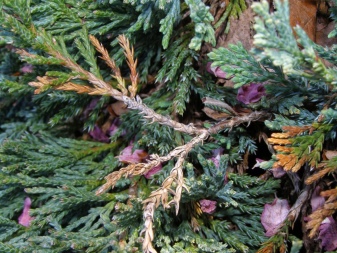

Brown shute is also a very unpleasant ailment, which is characterized by a yellowing of the crown and abundant falling of needles. You can usually notice it in the first month of summer. After getting rid of the crumbling branches, the tree is treated with the preparations "Skor", "Quadris", "Strobi". Preventive irrigation is carried out 2 times a year: in autumn and spring.
Various pests can also cause significant damage to the appearance and life of the coniferous culture. Among them:
- spider mite - acaricides "Aktaru", "Karbofos", "Actellik" will help to get rid of this unpleasant insect;
- aphid - dies from the effects of "Fitoverma";
- scabbards, moth-mining - such a drug as "Decis" is effective against them.
To prevent attacks in early autumn and early spring, sprinkling with solutions consisting of water and "Aktara", "Fundazol" or "Aktellik" is carried out.
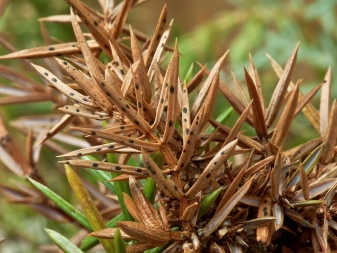
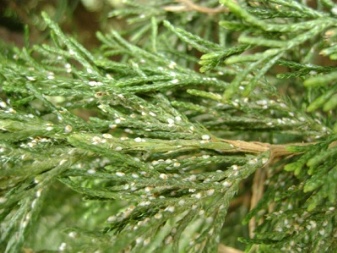
Use in landscape design
It is not for nothing that rocky juniper is popular with designers: its beautiful needles please with bright color all year round, an unusual shape dilutes the often familiar look. Such vegetation is planted both at a distance from other crops, and together with them. In the first case, they will look organic, for example, in the corners of the site, along the paths in parks, like a hedge. In the second, they are used to decorate rocky or heather gardens, flower beds with roses, hydrangeas.
The composition, which includes different varieties of rocky juniper, looks interesting. It can be embodied in rock gardens, mixborders, rabatkas. Miniature varieties are usually planted in pots or decorative pots and decorate gazebos and stairs with them.
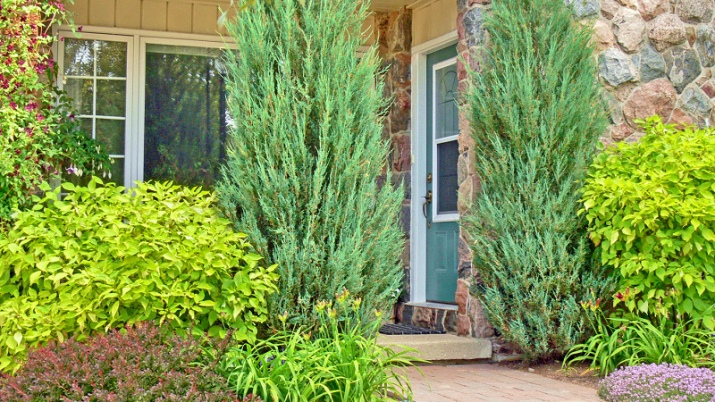

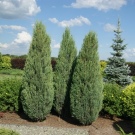
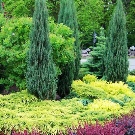

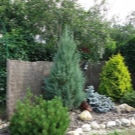
In the next video you will find additional information about the Blue Arrow rock juniper (Juniperus scopulorum Blue Arrow).



































































The comment was sent successfully.